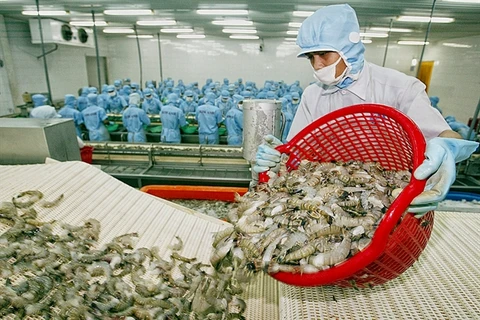 Workers packaging pangasius fillets at a processing plant of I.D.I International Development & Investment Corporation. (Photo: VNA)
Workers packaging pangasius fillets at a processing plant of I.D.I International Development & Investment Corporation. (Photo: VNA) The view was shared at a seminar on demand and trends of the seafood market after COVID-19 organised by the Vietnam Association of Seafood Exporters and Producers (VASEP) on August 24 in Ho Chi Minh City.
The COVID-19 pandemic, logistics disruptions due to the Russia-Ukraine conflict and compliance with regulations on illegal, unreported and unregulated fishing (IUU) are challenges facing the seafood industry.
Le Hang, VASEP director of communications, said the world seafood market in the past five years has grown by 16% with an annual import turnover of about 148.5 billion USD, of which, shrimp accounted for the highest proportion and increased the most (29%), while salmon increased 16%, and demand for tuna was less volatile.
Meanwhile, demand from the Chinese market has jumped 71% over the last five years, followed by the US with an increase of 32%. Most markets saw increased demand, except for Japan, which decreased by 6%, and Germany, which decreased slightly by 0.6%.
Exporting seafood to the EU market is facing many challenges because each market in the EU bloc has its own requirements.
In addition, inflation is making EU consumers tighten their spending and focus on moderately priced items. The lowest EUR/USD exchange rate in 20 years also makes consumers limit spending, forcing importers to re-negotiate with exporters, which delays imports.
Other challenges include stricter demands for EU market certification, and environmental and labour requirements, which can be serious problems for Vietnamese seafood producers.
To take full advantage of the EVFTA, VASEP is asking for more support from the Import-Export Department and the Ministry of Industry and Trade for businesses to make the most of preferential tariffs and apply the rules of origin to reduce obstacles when exporting seafood to the EU market.
The EU used to be Vietnam's largest pangasius import market, with peak sales of 511 million USD in 2010, accounting for 36% of Vietnam's pangasius exports. Vietnamese pangasius also accounted for 22% of the EU’s import of white fish.
However, in 2021, pangasius exports to the EU reached just over 106 million USD, accounting for 7% of Vietnam's total pangasius exports. In the EU white-meat fish import market, Vietnamese pangasius only accounts for 1.6% of market share.
The EVFTA, effective from August 1, 2020, brought excellent prospects for Vietnam's seafood exports, including pangasius, to this market. Accordingly, the export of pangasius products will receive tax reductions under a three-year roadmap.
Smoked pangasius exports will have tax reductions within seven years from the effective day of the agreement.
However, the advantages of tariffs did not promote an increase in pangasius exports to the EU in 2020 and 2021 because of the pandemic.
In addition, there is an issue regarding compliance with regulations against unreported and unregulated fishing (IUU). Four years since receiving a "yellow card", Vietnamese seafood export volume to the EU market declined by 3% during 2017-2021.
The Government has pledged to come up with appropriate and effective solutions to quickly solve the "yellow card" penalty.
Vietnam can then avoid the risk of receiving a "red card" and enjoy preferential tariffs and institutional changes from the EVFTA.
However, seafood exports to the EU still maintained a growth rate of 28% in July and 39% in the first seven months of this year, to 829 million USD, compared to the same period in 2021.
Seafood exports to the US in the first seven months reached nearly 1.5 billion USD, up 31% year on year, Hang said.
Meanwhile, seafood export value to China in the first seven months grew by 71% to 1 billion USD./.
VNA























